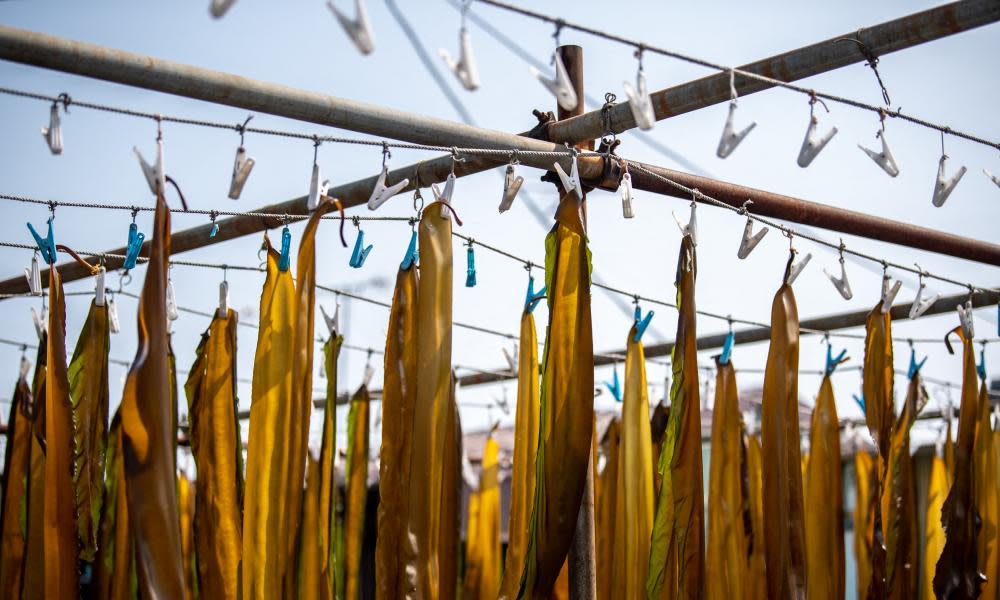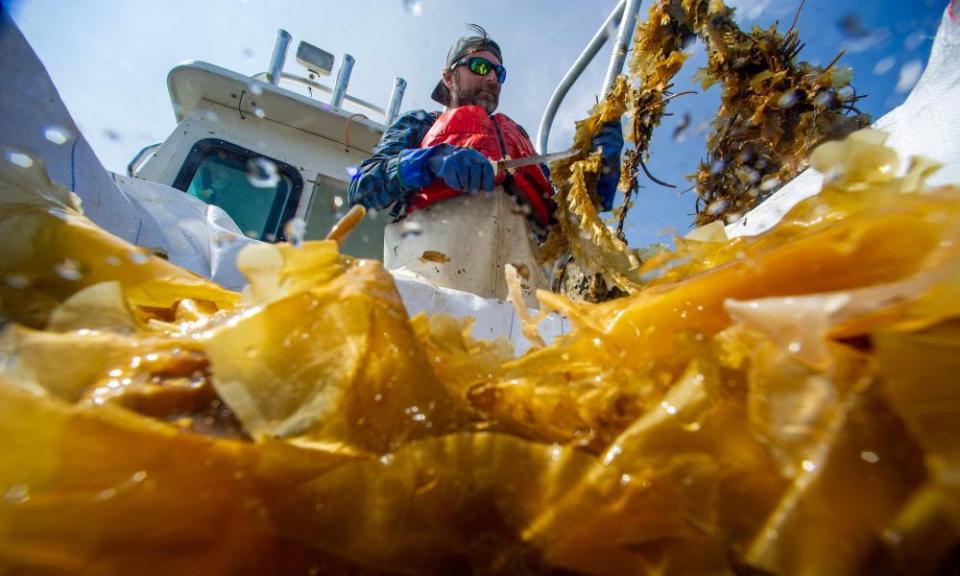It’s the ‘Swiss army knife of the sea’. But can kelp survive rising marine heat?

Ocean temperatures have hit record highs this year, growing so hot in some places that taking a dip in the sea feels like stepping into a hot tub. For kelp farmers, who grow an underwater crop with a life cycle highly dependent on temperature, that spells trouble for their harvests – and their nascent industry’s future.
“Over the last 30 or 40 years, we’ve seen a pretty big decline in the kelp populations around Long Island. In large part, that’s due to climate change and water temperatures increasing,” said Michael Doall, a former oyster farmer and marine scientist at Stony Brook University’s School of Marine & Atmospheric Sciences.
Related: Saved by seaweed: nuns and Native women heal polluted New York waters using kelp
Doall is just one of many scientists working on solutions that will help make the burgeoning industry more climate resilient. Their research subject, kelp, has been billed as the future of food: the sea vegetable doesn’t require land, fresh water or fertilizer to grow, allowing it to sidestep some of the harms that accompany traditional resource-intensive terrestrial agriculture.
It grows up to 2ft per day, making it efficient at pulling climate-warming carbon and ecosystem-disrupting nitrogen from land-based fertilizer runoff out of the water. And it’s a delicious ingredient that can be used to add a rich umami flavor to everything from sushi and burgers to pickles and salads.
“It’s often called the Swiss army knife of the sea, or the tofu of the sea. It can be turned into so many different things,” said Scott Lindell, a research specialist at Woods Hole Oceanographic Institution in Massachusetts.
Kelp has been farmed as food in Asia for millennia and harvested by tribes like the Shinnecock and used for everything from food and medicine to housing insulation in what’s now known as Long Island, New York, since long before settlers arrived. But kelp farming as a commercial endeavor – in which kelp is grown on tensioned ropes secured by anchors and buoys a few feet below the water’s surface that are pulled up for harvest – began in North America just a few decades ago.
It is increasingly being sold as a valuable food product in North America, as well as a useful ingredient in bioplastics, cosmetics and even renewable fuels.

Now, as interest ramps up in earnest on this side of the globe, kelp is running into a problem as the climate crisis turns up the temperature of the ocean. That’s throwing kelp’s complicated life cycle out of whack, which spells trouble for those farming it.
Historically, kelp growers have started each season by diving for wild kelp sorus, or reproductive tissue – the ocean equivalent of foraging for wild seed. That “seed”, as it’s called colloquially (though it’s technically a different kind of reproductive tissue, since kelp are algae rather than plants), is then grown in tanks in a nursery until it’s ready to be outplanted in the open ocean.
Related: ‘It’s a miracle crop’: the pioneers pushing the powers of seaweed
But the emergence of reproductive tissue is triggered by changes in water temperature, which means that as oceans warm, sorus is emerging later and later, truncating the growing season.
“Like with any other agricultural practice, when you have a shorter growing season, you get lower yields,” said Toby Sheppard Bloch, director of infrastructure at GreenWave, a non-profit focused on regenerative ocean farming.
When GreenWave’s founder Bren Smith first started farming kelp off the coast of Connecticut 20 years ago, he outplanted at the end of October, according to Bloch. But in the last couple years, Smith hasn’t been able to outplant until the end of December – a loss of up to eight weeks of growing time. That can make a big difference for farmers, who are often operating within slim financial margins.
Plus, gathering reproductive material from the ocean means there’s less left over to re-seed wild kelp beds in the future. As kelp farming scales up, this could pile additional pressures on wild kelp beds that are already threatened by warming waters and habitat loss.
“In the past, there’s been an assumption that there will always be an abundance of this wild material,” Bloch said. But as waters warm, that assumption may not hold.
These are just a few of the reasons that aquaculture researchers are looking for ways to cultivate “seed banks” for kelp that will reduce dependence on wild sorus. “A corn farmer doesn’t have to go find wild maize plants every year,” Bloch said. But since kelp has a more complex life cycle than the average land crop, it’s not quite as simple as storing dried corn seed in a cool dark place until next year.
Marine scientists like Charles Yarish, a professor emeritus at the University of Connecticut, have proven that in a lab setting, light and temperature cues can essentially press “pause” or “play” on kelp’s life cycle. This means kelp growers don’t have to be at the mercy of ocean temperatures and wild kelp beds – and they can cultivate kelp seed at any time.

Plus, this technique allows growers to “bulk” the sorus so that a larger number of “seedlings” can be grown with less reproductive material. “It’s a very efficient use of material in that sense,” Bloch said.
GreenWave has been working on replicating and testing that process in a much lower-budget setting, using tools like a “$69 coffee urn from a church basement” to pasteurize seawater in lieu of the quarter-million-dollar autoclave that would be used in a lab setting.
Related: In search of lost fruit: the explorers tracking down ancient trees before they are gone for ever
“We’re trying to figure out how to take the really smart things that [scientists are] developing, and make it something that the farmer might be able to operate on their own, so that farmers don’t have to rely on third parties for their seed, like a soy or corn farmer is dependent on Monsanto,” Bloch said.
Other researchers, like Lindell from Woods Hole, are working with their knowledge of kelp lifecycles to selectively breed the crop, hoping to select for traits like heat tolerance that might allow kelp to thrive in its current native range even as waters get warmer.
There are still plenty of barriers to overcome as the kelp aquaculture sector develops. But with GreenWave’s early pilots planting kelp from cultured reproductive material producing “stunning” results that nearly doubled yields over kelp planted from wild sorus, there’s reason for hope.
Plus, added Doall, the stakes are simply too high for the aquaculture community not to stick with this process until they get it right.
“There’s a lot riding on it,” said Doall. “If we’re able to domesticate it, it’s going to help the industry by leaps and bounds.”

